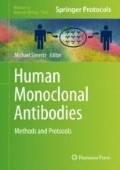Abstract
One of the major reasons for seeking human monoclonal antibodies has been to eliminate immunogenicity seen with rodent antibodies. Thus far, there has yet been no approach which absolutely abolishes that risk for cell-binding antibodies. In this short article, I draw attention to classical work which shows that monomeric immunoglobulins are intrinsically tolerogenic if they can be prevented from creating aggregates or immune complexes. Based on these classical studies two approaches for active tolerization to therapeutic antibodies are described.
Access this chapter
Tax calculation will be finalised at checkout
Purchases are for personal use only
References
Kohler G, Milstein C (1975) Continuous cultures of fused cells secreting antibody of predefined specificity. Nature 256:495–497
Steinitz M et al (1977) EB virus-induced B lymphocyte cell lines producing specific antibody. Nature 269:420–422
Bruggemann M et al (1989) The immunogenicity of chimeric antibodies. J Exp Med 170:2153–2157
Jones PT et al (1986) Replacing the complementarity-determining regions in a human antibody with those from a mouse. Nature 321:522–525
Riechmann L et al (1988) Reshaping human antibodies for therapy. Nature 332:323–327
Bruggemann M et al (1989) A repertoire of monoclonal antibodies with human heavy chains from transgenic mice. Proc Natl Acad Sci USA 86:6709–6713
Lonberg N (2005) Human antibodies from transgenic animals. Nat Biotechnol 23:1117–1125
Winter G et al (1994) Making antibodies by phage display technology. Annu Rev Immunol 12:433–455
Clark M (2000) Antibody humanization: a case of the “Emperor’s new clothes”? Immunol Today 21:397–402
Chiller JM et al (1970) Cellular sites of immunologic unresponsiveness. Proc Natl Acad Sci USA 65:551–556
Benjamin RJ et al (1986) Tolerance to rat monoclonal antibodies. Implications for serotherapy. J Exp Med 163:1539–1552
Waldmann H et al (2008) Reprogramming the immune system: co-receptor blockade as a paradigm for harnessing tolerance mechanisms. Immunol Rev 223:361–370
Rebello PR et al (1999) Anti-globulin responses to rat and humanized CAMPATH-1 monoclonal antibody used to treat transplant rejection. Transplantation 68:1417–1420
Eichmann K (1973) Idiotype expression and the inheritance of mouse antibody clones. J Exp Med 137:603–621
Somerfield J et al (2010) A novel strategy to reduce the immunogenicity of biological therapies. J Immunol 185:763–768
Feldmann M, Maini RN (2001) Anti-TNF alpha therapy of rheumatoid arthritis: what have we learned? Annu Rev Immunol 19:163–196
De Groot AS, Scott DW (2007) Immunogenicity of protein therapeutics. Trends Immunol 28:482–490
Harding FA et al (2010) The immunogenicity of humanized and fully human antibodies: residual immunogenicity resides in the CDR regions. MAbs 2:256–265
Isaacs JD, Waldmann H (1994) Helplessness as a strategy for avoiding antiglobulin responses to therapeutic monoclonal antibodies. Ther Immunol 1:303–312
Gilliland LK et al (1999) Elimination of the immunogenicity of therapeutic antibodies. J Immunol 162:3663–3671
Waldmann HF,Gillilkand MK, Graca L (2008) Therapeutic antibodies. US 7,465,790 B2
Author information
Authors and Affiliations
Editor information
Editors and Affiliations
Rights and permissions
Copyright information
© 2014 Springer Science+Business Media, LLC
About this protocol
Cite this protocol
Waldmann, H. (2014). Human Monoclonal Antibodies: The Residual Challenge of Antibody Immunogenicity. In: Steinitz, M. (eds) Human Monoclonal Antibodies. Methods in Molecular Biology, vol 1060. Humana, Totowa, NJ. https://doi.org/10.1007/978-1-62703-586-6_1
Download citation
DOI: https://doi.org/10.1007/978-1-62703-586-6_1
Published:
Publisher Name: Humana, Totowa, NJ
Print ISBN: 978-1-62703-585-9
Online ISBN: 978-1-62703-586-6
eBook Packages: Springer Protocols

